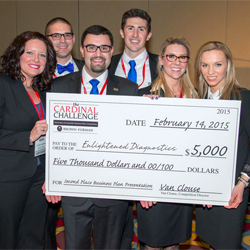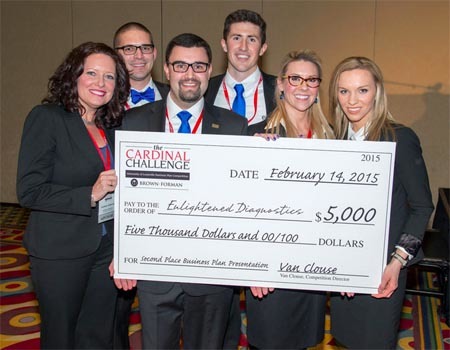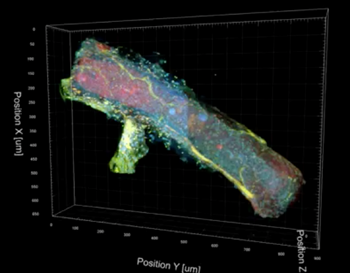

(L to R): Gaylene Anderson, Colin O'Toole, Scott Manwaring,
Chris Cali, Megan Usovsky and Victoria Zellmer
Enlightened Diagnosis (EnDx), a company represented by a team of University of Notre Dame graduate students, recently earned second place in the 2015 Brown Forman Cardinal Challenge at the University of Louisville. The competition included 12 teams as finalists from university entrepreneurship programs around the world.
EnDx presented a business plan for a new device to better analyze and image breast cancer tumor biopsies. Traditional methods of tumor analysis involve cutting very thin slices of the biopsy, removing the lipids from the sample, and analyzing the sample under a microscope. A problem with this method is that it neglects to consider that cancer develops in a 3-D landscape with unique spatial and structural features that characterize different cancer stages and grades. Analysis of only a small section of a tumor can potentially lead to an incorrect diagnosis for the cancer patient.
The new device, developed by Siyuan Zhang, the Nancy Dee Assistant Professor of Cancer Research, Jeremiah Zartman, assistant professor of chemical and biomolecular engineering, and David Hoelzle, assistant professor of aerospace and mechanical engineering, can automatically process a tumor biopsy that results in a data-rich 3-D image of the tumor and its surrounding environment. Named Reveal3DTM, the device clears the lipid out of the biopsy, stains the cells, and take images of the cells, while leaving the biopsy completely intact. The advantage of this technology is that clinicians can see data that has never been available before, identify the different stages of cancer within one sample, and lower the risk of misdiagnosis.
Gaylene Anderson of Notre Dame’s Office of Technology Transfer and Senior Innovations Officer at Cleveland Clinic Innovations, assembled the diverse group of students to help the faculty commercialize their work. Since last fall, patent law student and chief executive officer Megan Usovsky, J.D.; entrepreneurship master’s student and chief operating officer Chris Cali; third year biological sciences graduate student and chief scientific officer Victoria Zellmer; MBA student and chief technology officer Scott Manwaring; and master’s of science in accountancy student and chief financial officer Colin O’Toole, have collaborated to create a business plan for Reveal3DTM.

3-D image of a mammary duct
When asked about her experience working with the five students, Anderson said, “This is an amazing team of students, and they each have expertise and backgrounds that are needed to build a great, comprehensive business plan. They have worked with me since August – spending hundreds of hours over evenings and weekends. It’s a lot of work, but also a lot of fun!”
Participation in the Cardinal Challenge included submitting a 10-page business plan and giving a 15 minute pitch to judges and potential investors. For their second place prize, EnDx won $5,000.
“This is one of the hardest things I’ve ever done,” said Zellmer, who is a graduate student in Zhang’s lab. “As a scientist, I’ve learned that I need to choose words and descriptions carefully. Being able to clearly explain and demonstrate the science behind the technology is extremely important when meeting with potential investors who may not have a science background.”
Notre Dame has already completed patent applications for the device and is working with the Cleveland Clinic to help commercialize the technology. In addition, they are looking for investors to help get their new company started. EnDx will participate in Notre Dame’s McClosky Business Plan Competition in April in hopes of winning additional funding for the company.
“I’ve learned that science and business are not that different,” Zellmer explained. “Market research is very similar to predictive modeling in research. The same thought process you would use in creating a hypothesis and experiment is the same you would use to create a business plan. Learning how to think like an entrepreneur has definitely made me a better scientist.”